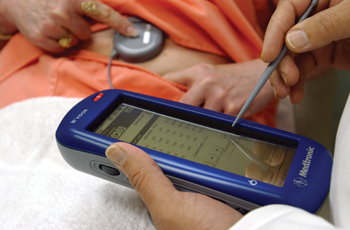
Willie Melvin, M.D., assistant professor of Surgery, adjusts patient Donna McCurry's gastric pacer, a device implanted in her abdomen that electronically stimulates her stomach to empty on a regular cycle.
photo by Dana Johnson
New device helps ease stomach paralysis
Donna McCurry remembers when her life wasn't really a life. Suffering from gastroparesis, a digestive disorder, she was vomiting 20 to 30 times a day, constantly nauseated and visiting the Emergency Room for fluids every other day.
“That's pretty much how life was for some time,” McCurry said. “What I thought was a bad stomach virus turned out to be a condition that I was told I was just going to have to live with.”
Gastroparesis, or stomach paralysis, is a disorder in which the stomach is unable to contract properly and therefore cannot pass food on to the small intestine. The most common symptoms are early fullness after eating, as well as nausea and vomiting, which often leads to weight loss.
Gastroparesis can be caused by diabetes, infections, injury to the vagus nerve through surgery and various other means, or it can be idiopathic — with no known cause.
“As soon as my condition was diagnosed, doctors just wanted to treat my symptoms, not the problem. And some doctors didn't believe it was a real condition — I was accused of everything from having an eating disorder to being a drug addict,” McCurry said. “So I began looking for a better solution.”
McCurry came across a relatively new method to treat gastroparesis called a gastric pacer, which electronically stimulates the stomach, causing it to empty. She immediately began pursuing the treatment and came to Vanderbilt, which is the only medical center in Tennessee offering the surgery.
The gastric pacer, called Enterra Therapy, is a surgically implanted device that works in a similar fashion to a cardiac pacemaker. Two electrodes are placed in the muscle wall of the stomach, with a lead connected to an implantable neurostimulator that's placed beneath the skin.
“The pacer works by stimulating the stomach to empty,” said Willie Melvin, M.D., assistant professor of Surgery, who performs the gastric pacer surgery at Vanderbilt. “The stimulator does not rely on input from the stomach, instead it is set on a cycle, and keeps the stomach actively stimulated, moving food through.” This is different from a recently developed pacer that is used for weight loss, which basically performs in the opposite manner.
Enterra Therapy has been approved by the FDA as a humanitarian use device, which is a designation reserved for devices treating rare medical conditions. Because of this, patients sometimes struggle to get their insurance companies to cover the procedure. This was the case for McCurry, but after fighting weekly for months, she was finally approved for the surgery.
“I couldn't have asked for more,” she said. “Before the surgery, I was thinking about my funeral. Now, thanks to Dr. Melvin — who listened to me and truly wanted to help me — I have more good days than bad days. The gastric pacer changed my life; it gave me my life back.”
“It may be hard to understand how this disorder can affect someone's life,” Melvin said, “But these patients can't eat, they're constantly feeling terrible and vomiting, and they really can't have much of a life. And when they can't eat, they get weak and feel even worse. Sometimes medications work, but sometimes they don't. We're happy that the pacer gives patients another option for those that are recalcitrant to medical therapy.”
Charity Deete Smith was the first patient at Vanderbilt to undergo the procedure two years ago. Smith, 18 at the time, had suffered from idiopathic gastroparesis for two years.
“I couldn't go to school; I was homebound,” she said. “I was nauseated and throwing up all the time. They put me on a feeding tube but after awhile, I couldn't even do tube feeds.”
Smith said she was nervous and excited about undergoing the procedure, but she'd do it all over again. Since the surgery, Smith has started attending college and said she has good days and bad days, but she's much better than before the pacer.
Since 1999, more than a thousand pacers have been placed, 15 of which have been at Vanderbilt. Melvin performs the procedure and works with Christopher Lind, M.D., associate professor of Medicine, to identify and evaluate surgical candidates. The surgery is done laparoscopically and usually takes an hour and a half to complete. Patients usually have a one- to two-day hospital stay, with follow-up visits to adjust the pacer to meet their needs. The therapy is reversible and the pacer can be turned off at any time.
“The best case scenario is patients are able to go off of all medications and are able to eat or are able to function on medication,” Melvin said. “So far, we've had very good results. The pacer is helping patients regain their lives.”













